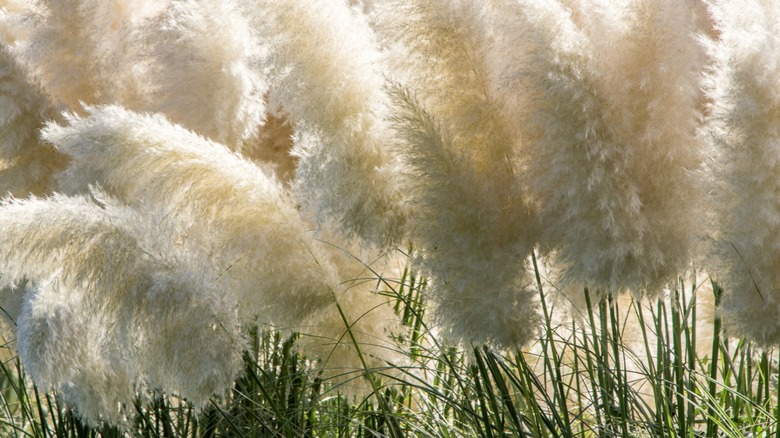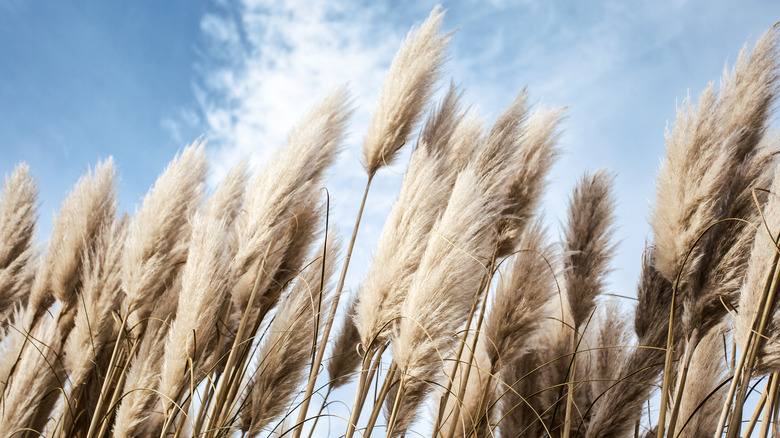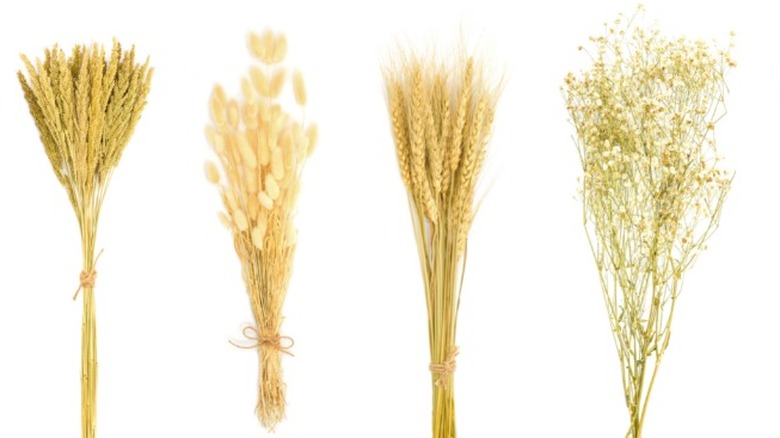How To Successfully Care For Pampas Grass
Previously, we learned that pampas grass was proliferating in certain regions, so we suggested eight tips to get rid of pampas grass and control its invasive nature. MasterClass writes that pampas grass, with the scientific name Cortaderia selloana, is a member of the Poaceae plant family, related to other tall plants like wheat and bamboo. As a flowering perennial, it typically blooms in the spring and ceases growth in the winter before returning the following year.
Native to South American countries such as Argentina, this ornamental grass is a low-maintenance plant that thrives best in USDA zones 7 to 11. However, Gardening Know How explains that if the conditions are right, you can also grow pampas grass in USDA zone 6. A notable feature of pampas grass is its ability to grow as tall as 10 to 13 feet, per HGTV. If you want the white or blonde perennial waving in your own garden, read on to learn how to properly grow and care for your pampas grass so it does not overtake your entire outdoor space.
How to use pampas grass in garden
Having pampas grass in your garden could come with more benefits beyond just satisfying your personal taste. For instance, Better Homes & Gardens writes that these plants are great to grab plenty of attention. If you're looking to set your garden apart from the others on your block, creating a screen or border with just four to six pampas grass plants would certainly do the trick.
If you live within a region that is prone to erosion problems, strategically planted pampas grass could help to stabilize the area. SF Gate explains that this is because ornamental grasses such as pampas grass grow in thick clumps, and their network of roots holds the soil even in their dormant winter months. If your house is located near a hill or a slope, you may want to consider planting this in your garden to stabilize the soil and support the roots of other plants.
As a drought-resistant ornamental grass, pampas grass does not require much moisture, allowing you to conserve water use or remain worry-free when a heatwave hits. This would also allow you to pay more care to the other flowering plants or grasses in your garden. Talk about being a great team player and a good companion plant!
How to grow pampas grass
You cannot care for pampas grass if you do not grow it first, now can you? So we'll take a minute to go back to the basics. Successfully growing pampas grass requires the bare minimum in terms of long-term maintenance, but you should use a few strategies to start things off right.
MasterClass proposes planting seedlings in the early spring before the growing season, as the perennial plant remains dormant in the colder winter months and won't grow into its new environment. They go on to suggest planting seedlings 15 inches deep in rich, well-draining soil, at least 6 feet apart. This spacing is so the plants have plenty of room to grow, as they are self-seeding and will multiply on their own. This also ensures you'll have enough room to weed in between the plants. Water thoroughly after planting to help the roots grow.
Pampas grass can withstand some shade, but they require full sun to truly thrive. SF Gate explains that they should be planted in an area with plenty of sunlight in order to reach their full growth and remain healthy enough to ward off disease and compete with other plants. Happy DIY Home specifies that this means your pampas grass should receive at least six hours of direct sunlight each day.
How to care for pampas grass
Frankly, pampas grass is a very low-maintenance plant. In simple language, you'll hardly need to do anything to get them to grow, which may be good news for anyone with a brown thumb. However, because of their invasive nature, you will have to tend to them to ensure they do not take over a bigger area than intended. Garden Beast assures us that the plant can be managed with some care in late fall.
When pruning your pampas grass, be sure to wear gloves, as The Spruce warns that their foliage is sharp enough to cut skin. Use garden shears to cut the stalks down to just a couple inches below the ground to encourage new growth the following season. Garden Beast advises you take extra care when removing and disposing of the flower stalks in order to avoid accidentally spreading seed in your yard or your neighbors. If you don't, the self-sowing seeds can be carried by the wind to other areas and take root on their own. Although pruning can be tedious, it's an effective method of keeping the plant attractive and in-check.
Unlike some other grasses, pampas grass require very little water. Be aware, however, that pampas grass is quite dry and thus highly flammable. You should also avoid planting this grass in a high-risk area such as beside a grill so that you do not have a fire hazard on your hands, per Our Grass Plants.
Varieties of pampas grass
There are 25 varieties of pampas grass of the species Cortaderia selloana, according to Epic Gardening. One of the most popular varieties is the 'Gold Band' which is named for its golden plumed foliage and can grow 4 to 6 feet tall. This variety is originally native to Argentina, and blooms from the summer into the fall, per San Marcos Growers.
A dwarf variety of the species is known as Cortaderia selloana 'Pumila'. It has white plumes that bloom between June and July and grow to just 3 to 6 feet tall, writes Our Grass Plants. As a smaller plant, this variety is a good choice for growing indoors in a container.
There are other species of ornamental grasses available, but they have more drawbacks than the Cortaderia selloana. Plant Right says that the fast-growing Cortaderia jubata is widely considered an invasive species, and the Saccharum ravenna, better known as hardy pampas grass, is also highly invasive, according to Gardening Know How. In our opinion, this leaves Cortaderia selloana as the superior choice, especially since there are plenty of options with over 25 varieties to choose from.
Is pampas grass toxic?
A lot of questions have been raised as to the toxicity of pampas plants to pets and humans. When you are a pet owner or have a toddler running around in your home, you want to be quite careful about the kind of plants you choose to keep indoors and in your garden, writes Den Garden. To debunk any rumors you may have heard about pampas grass, the ASPCA has declared pampas grass non-toxic to animals and of course, narrowing it down, to your pets.
However, it is imperative to note that just like other plants, the ingestion of pampas grass by any of your pets could cause heartburn or nausea, so you still want to be careful, says Pampas Place. For humans, the aforementioned site also claims that pampas grass cannot be a source of plant poisoning. If ingested, it may cause certain sensitivities, and this is especially true for children.
Beyond its non-toxicity, it's important to note that this plant can still be hazardous due to the sharp edges of its foliage. Before planting, you should consider its potential to cut you, your kids, or your pets, as discussed by Gardening Know How. You can take precautions such as wearing gardening gloves or planting in areas inaccessible to pets and children so that you can still enjoy pampas grass in your garden.
How to repot pampas grass
Frankly, planting pampas grass in a pot is not the best idea, as it will limit its spectacular size. If you're determined nonetheless, Hunker claims you are on track, and points out that this method allows you to control its growth, thereby limiting its invasive potential. Additionally, a lot of people start their pampas grass in pots indoors during the winter to transplant later.
Transplanting pampas grass can be done in just a few steps. The first thing to do is to water the plant thoroughly a day before. Doing this ensures that the soil is soft and easier to work with when you want to transplant, writes SF Gate. Next, you'll need to prepare the ground. If you don't have time to prepare the ground beforehand, or anticipate that the plant will be uprooted for a while, SF Gate recommends you cover the roots with wet burlap to prevent them from drying out. For your pampas grass' new home, you want to dig a hole that is twice as wide as the clump and just a little deeper, says Gardening Channel. To remove the plant from its pot or ground, cut a circle around the plant with a shovel and then lift it out, carrying the entire root ball. Place it in the newly dug hole, add some compost around the roots, and cover with soil before finishing off with mulch around the stalks. Finally, water consistently for the next few days.
How to use pampas grass as interior décor
Pampas grass has been making rounds on social media as a truly spectacular interior décor element. Aside from having these beauties outdoors swaying in the breeze, you can also cut their long stalks and bring them indoors, especially if you love plants, but have a brown thumb. House Beautiful explains that this is because the cut flowers are essentially eternal — seriously, they require no water or sunlight to survive in your home. Best of all, they can complement any space without fuss due to their neutral color palette.
If you are considering pampas grass as interior décor, Posh Pennies says that you need not worry about the current style of your home, and the pampas grass is versatile enough to fit in with a range of interiors, from rustic to contemporary. This is also a plant you can use all year round, and it pairs nicely with other dried, low-maintenance bouquets. According to The Spruce, you can keep things simple with a classic vase of lush white flowers, or make a unique wreath of pampas grass to hang on your wall. There are endless ways to unleash your creativity, and you might just come up with something phenomenal.







